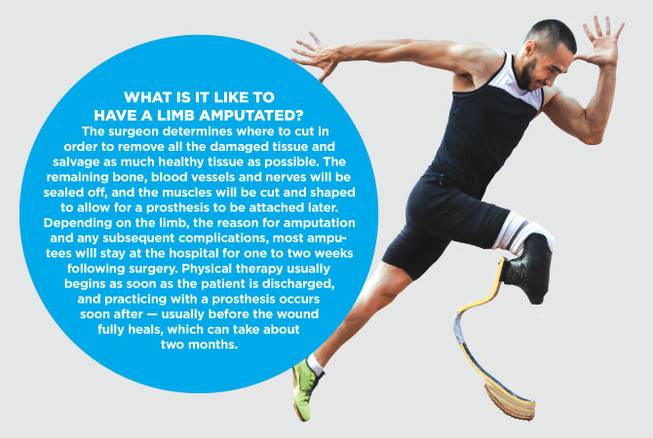
Monday, April 10, 2017 | 2 a.m.
The Centers for Disease Control and Prevention estimates there are nearly 2 million amputees living in the U.S., and more than 500 Americans lose a limb each day. Even considering the prevalence of limb loss, the subject is widely under- represented and often misunderstood.
“I believe there is a negative stigma surrounding limb loss,” said Jessica Wise, MD, surgical resident at MountainView Hospital and founder of One Leg Up On Life, a nonprofit organization dedicated to providing prosthetic limbs to children in need. “I think people tend to look down on anyone who is different than them and criticize those differences. But I also think it can be corrected if the general population became more educated on the subject and more familiar with amputees. Amputees are just everyday people and should not be treated any differently.”
Wise has been personally affected by limb loss — in 2015, her twin sister, Christy, had her leg amputated following a boating accident. And while April is Limb Loss Awareness Month, it’s just one of many opportunities to empower individuals whose lives have been forever changed.
Common reasons for limb loss
Birth defects, traumatic injuries and disease are common reasons someone might lose a limb. Complications that stem from diabetes and vascular disease account for the majority of amputations, and some cancer patients may be subject to amputation as well.
Injuries that occur during military combat, and car, motorcycle and boating accidents also are common causes.
“Amputations caused by traumatic injury occur at varying ages, but usually in the 15 to 35 age range,” Wise said. “Amputations caused by disease tend to occur in older patients, between the ages of 65 and 80.”
Leg amputation, both above and below the knee, is generally more common than arm and hand amputation.
What is it like to have a limb amputated?
The surgeon determines where to cut in order to remove all the damaged tissue and salvage as much healthy tissue as possible. The remaining bone, blood vessels and nerves will be sealed off, and the muscles will be cut and shaped to allow for a prosthesis to be attached later.
Depending on the limb, the reason for amputation and any subsequent complications, most amputees will stay at the hospital for one to two weeks following surgery.
Physical therapy usually begins as soon as the patient is discharged, and practicing with a prosthesis occurs soon after — usually before the wound fully heals, which can take about two months.
What are phantom pains?
“Phantom pains” is a term that describes ongoing, physical sensation in the limb that has been removed. Most patients experience some degree of phantom pains following an amputation. They can feel shooting pain, burning or even itching in the limb that is no longer there.
“It’s not entirely known why phantom pains occur, but one theory is that your brain forms pain memories when the nerves are cut or trauma is sustained to the limb. Although the nerve is cut during amputation, the nerve-pain pathway continues to cycle in the brain,” Wise said.
In some cases, phantom pains can be avoided if the nerve ends are deadened within 12 hours of the injury, which prevents the formation of pain memory pathways. There also are medications and therapies that can help. “For some patients, phantom pains last a few months or years before gradually improving, and for others they can last a lifetime,” Wise said.
Recovering after limb loss
Amputees have a long road to recovery. Most patients will need to get comfortable with a prosthetic and will undergo physical therapy for months or years following the amputation. This process is personal and can vary greatly from patient to patient.
Recovery also can be affected by the cause of amputation, the specific limb lost and whether the amputation occurred above or below the joint.
Further, “younger, active and physically fit patients usually have an easier time adapting to a prosthetic device. Elderly amputees are more likely to use a wheelchair after an amputation rather than learn to walk again on a prosthesis. But it depends on the attitude and motivation on the patient,” Wise said.
Amputations that occur above the joint tend to be more difficult to recover from and can affect the patient’s ability to use a prosthesis. “Prosthetics are amazing these days, but joints are very hard to replicate,” Wise said.
Beyond that, lower limb and upper limb amputation patients have a different recovery process as well. Leg amputees are more likely to use a prosthetic than arm amputees are. Wise said many arm amputees often prefer to adapt to life using only their other hand.
Depression is also a major health concern for amputees. Limb loss can cause patients to question their self-worth and self-image, and can drastically alter their lifestyle, career, recreational activities and more.
While the recovery process is extremely difficult, it’s important to remember that it is also entirely possible, especially with patience, acceptance and the right attitude.
Most patients are able to adapt and successfully resume their lives following an amputation.
“With the invention of many different types prosthetic devices, there is now very little amputees can’t do with the right equipment. My sister walks, flies airplanes, runs, bikes, wakeboards, skydives and swims with her prosthetic legs. She has at least five different prosthetics that allow her to do each activity. It’s not easy — imagine having to bring a large suitcase full of legs when you’re doing multiple activities in one weekend — but it’s possible,” Wise said.

Join the Discussion:
Check this out for a full explanation of our conversion to the LiveFyre commenting system and instructions on how to sign up for an account.
Full comments policy